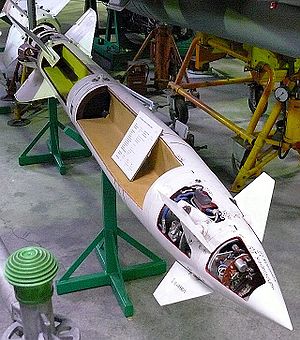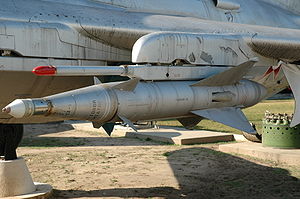| Kh-66/Kh-23 Grom (NATO reporting name: AS-7 'Kerry') | |
|---|---|
 AS-7 'Kerry' | |
| Type | Tactical air-to-surface missile |
| Place of origin | Soviet Union |
| Service history | |
| In service | Kh-66 :20 June 1968[1] Kh-23 :1973[2] Kh-23M :1974[2] |
| Used by | FSU, Warsaw Pact, Iraq, India[3] |
| Production history | |
| Designer | Yurii N. Korolyov[1] |
| Manufacturer | Zvezda-Strela |
| Specifications | |
| Mass | A921 :287 kg (633 lb)[3] |
| Length | A921 :3.525 m (11 ft 7 in)[3] |
| Diameter | 27.5 cm (10.8 in)[3] |
| Wingspan | 78.5 cm (2 ft 6.9 in)[3] |
| Warhead weight | 111 kg (245 lb)[3] |
| Engine | Solid fuel rocket[3] |
Operational range | 2–10 km (1.1–5.4 nmi)[3] |
| Maximum speed | 2,160–2,700 km/h (1,340–1,680 mph)[3] |
Guidance system | Kh-66 :Line-Of-Sight Beam riding Kh-23 :Radio command guidance Grom-B :TV guidance |
Launch platform | Yak-38,MiG-21PFM, MiG-23, MiG-27, Su-17M3/20/22/22M3/M4,[3] |

The Zvezda Kh-66 and Kh-23 Grom (Russian: Х-23 Гром 'Thunder'; NATO: AS-7 'Kerry') are a family of early Soviet tactical air-to-surface missiles with a range of 10 km. They were intended for use against small ground or naval targets. The Kh-66 was effectively a heavy-warhead, beam-riding version of the K-8 (AA-3 'Anab') air-to-air missile rushed into service in Vietnam in 1968. The Kh-23 was an improved Kh-66 with command-guidance, similar to the AGM-12 Bullpup.
- ^ a b Cite error: The named reference
historywas invoked but never defined (see the help page). - ^ a b Cite error: The named reference
JMRwas invoked but never defined (see the help page). - ^ a b c d e f g h i j Cite error: The named reference
NIGWNWSwas invoked but never defined (see the help page).